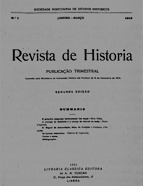

................................
"It is thus imperative that the reform of higher education includes the establishment of a centre for national studies, or at the very least ensures a long-standing representation of such studies, even if fragmented. [...] Equally urgent was the creation of a historical journal to compile all monographs and materials contributing to the sacred task of nationalising the country. An example has been set: in 1819, following the revival that ensued after the disasters inflicted by Napoleon, a Historical Society was founded in Berlin, with members including Niebuhr, the Brothers Grimm, Savigny, Schlegel, and Ranke, among others. Let us, therefore, instil a new and national spirit into the country, which has given itself a new form ." ( O Espírito Histórico , 1st ed., p. 12) As early as 1910, the foundational ideas for establishing an association devoted to historical studies, particularly those focusing on national history, were thus articulated. This marked the first step towards the creation of the Portuguese Society of Historical Studies. It should be noted that while the Society emerged in reaction to the revolutionary period and its conception of progress, its existence closely mirrored the lifespan of the First Republic.
I n 1911, the "circular-programme" was published ( Boletim da Sociedade de Geografia de Lisboa , pp. 120–125), a foundational text of the SPEH that outlined its programmatic bases. Addressed to "all Portuguese professionals in the historical sciences" ( op. cit. , p. 120), it was signed by four prominent figures: Fidelino de Figueiredo, Cristovão Magalhães Sepúlveda, David Lopes, and José Leite de Vasconcelos. A notable eclecticism can be observed in the fields of study represented by the aforementioned figures—a natural characteristic for the period—including a military officer, an Arabist, an ethnologist, and Fidelino, who later pursued a long career in literary history, criticism, and essay writing. Furthermore, similarities between the circular-programme and O Espírito Histórico suggest the possibility that the text of the circular was authored by Fidelino de Figueiredo . As part of the reformist vision articulated in Fidelino’s concept of the historical spirit , the SPEH emerged as one of the most significant and ambitious projects. The circular-programme revealed two main dimensions: a clear ideological stance and an epistemological proposition. The SPEH articulated four major objectives in its programme: to unify the scientific community in the social sciences; to disseminate research outputs in this field; to ensure the social recognition of historians' work by facilitating the reception of their publications and encouraging further scholarly production; and to establish a forum for discussion and critique in the social sciences ( Fidelino de Figueiredo, " Programa da Sociedade Portuguesa de Estudos Históricos " [Programme of the Portuguese Society of Historical Studies] Estudos de Literatura [Literature Studies] 1st Series (1910–1916), 1917, pp. 215–224). The programme did not address the role of universities or the critical and scientific training of historians, possibly because its authors did not regard the university as an appropriate venue for the type of discussion they envisioned for the SPEH.
This work is financed by national funds through FCT - Foundation for Science and Technology, I.P, in the scope of the projects UIDB/04311/2020 and UIDP/04311/2020.
